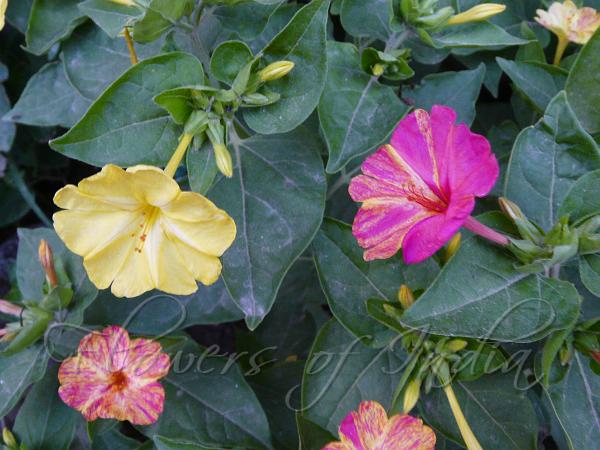|
| Four O'clock |
|

|

| File size | 2475916 |
| Original date | 6/21/09 7:07 PM |
| Resolution | 2560 x 1920 |
| Flash | Flash did not fire, auto |
| Focal length | 4.7mm |
| Exposure time | 1/8s |
| Aperture | 2.8 |
| Focus Distance | |
| Metering Mode | Multi-segment |
| Camera make | Panasonic |
| Camera model | DMC-FZ18 |
| Sensor type | OneChipColorArea |
|
|
|
|
Photo: |
Botanical name: Mirabilis jalapa Family: Nyctaginaceae (Bougainvillea family)
Four o'clock flowers are trumpet shaped, about an inch across at the end
and about two inches long. They open in the evening and wilt the next
morning. Four o'clocks are leafy, shrublike, multi-branched perennials
which bloom throughout summer. The plants are erect and spreading, 2-3 ft
tall and just as wide. They have numerous branches and opposite, pointed
leaves 2-4 in long. The fragrant flowers are borne singly or in clusters,
and can be red, magenta, pink, yellow or white, sometimes with more than
one color on the same plant. Like Petunia, bicolored flowers can also be
grown. The plants continue to produce new flowers from late spring until
fall. Four o'clocks have large, black carrot shaped tubers that can be a
foot or more long. In warm regions, the roots can weigh up to 18 kg or
more. The flowers are used in food colouring. An edible crimson dye is
obtained from the flowers to color cakes and jellies.
Medicinal uses: In herbal medicine, parts of the plant may be used as a diuretic,
purgative, and for vulnerary (wound healing) purposes. The root is
believed to be an aphrodisiac as well as having diuretic and purgative
properties. It is also used in the treatment of dropsy. The leaves are
used to reduce inflammation. A decoction of them (by mashing and boiling)
is used to treat abscesses. Leaf juice may be used to treat wounds. The
bulbous roots of the flower have a laxative effect.
In herbal medicine, parts of the plant may be used as a diuretic,
purgative, and for vulnerary (wound healing) purposes. The root is
believed to be an aphrodisiac as well as having diuretic and purgative
properties. It is also used in the treatment of dropsy. The leaves are
used to reduce inflammation. A decoction of them (by mashing and boiling)
is used to treat abscesses. Leaf juice may be used to treat wounds. The
bulbous roots of the flower have a laxative effect.
Medicinal uses:
 In herbal medicine, parts of the plant may be used as a diuretic,
purgative, and for vulnerary (wound healing) purposes. The root is
believed to be an aphrodisiac as well as having diuretic and purgative
properties. It is also used in the treatment of dropsy. The leaves are
used to reduce inflammation. A decoction of them (by mashing and boiling)
is used to treat abscesses. Leaf juice may be used to treat wounds. The
bulbous roots of the flower have a laxative effect.
In herbal medicine, parts of the plant may be used as a diuretic,
purgative, and for vulnerary (wound healing) purposes. The root is
believed to be an aphrodisiac as well as having diuretic and purgative
properties. It is also used in the treatment of dropsy. The leaves are
used to reduce inflammation. A decoction of them (by mashing and boiling)
is used to treat abscesses. Leaf juice may be used to treat wounds. The
bulbous roots of the flower have a laxative effect. | Identification credit: Sinam Dhaneshwari | Photographed in Jamia Millia Islamia, Delhi & Rajouri, J&K. |
• Is this flower misidentified? If yes,